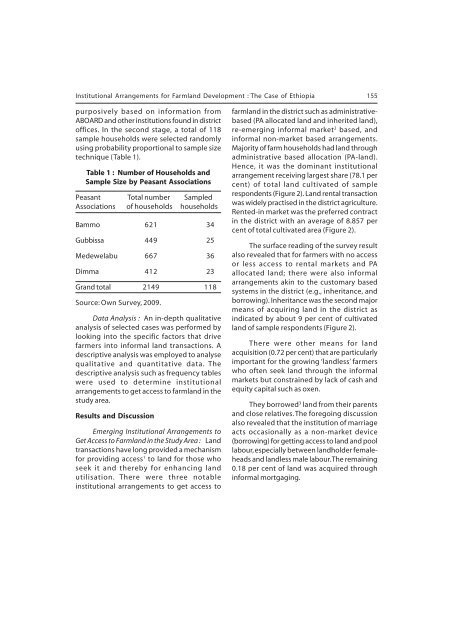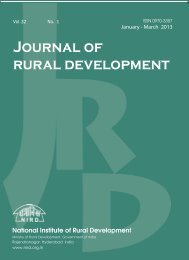contents - National Institute of Rural Development
contents - National Institute of Rural Development
contents - National Institute of Rural Development
Create successful ePaper yourself
Turn your PDF publications into a flip-book with our unique Google optimized e-Paper software.
Institutional Arrangements for Farmland <strong>Development</strong> : The Case <strong>of</strong> Ethiopia 155<br />
purposively based on information from<br />
ABOARD and other institutions found in district<br />
<strong>of</strong>fices. In the second stage, a total <strong>of</strong> 118<br />
sample households were selected randomly<br />
using probability proportional to sample size<br />
technique (Table 1).<br />
Table 1 : Number <strong>of</strong> Households and<br />
Sample Size by Peasant Associations<br />
Peasant Total number Sampled<br />
Associations <strong>of</strong> households households<br />
Bammo 621 34<br />
Gubbissa 449 25<br />
Medewelabu 667 36<br />
Dimma 412 23<br />
Grand total 2149 118<br />
Source: Own Survey, 2009.<br />
Data Analysis : An in-depth qualitative<br />
analysis <strong>of</strong> selected cases was performed by<br />
looking into the specific factors that drive<br />
farmers into informal land transactions. A<br />
descriptive analysis was employed to analyse<br />
qualitative and quantitative data. The<br />
descriptive analysis such as frequency tables<br />
were used to determine institutional<br />
arrangements to get access to farmland in the<br />
study area.<br />
Results and Discussion<br />
Emerging Institutional Arrangements to<br />
Get Access to Farmland in the Study Area : Land<br />
transactions have long provided a mechanism<br />
for providing access 1 to land for those who<br />
seek it and thereby for enhancing land<br />
utilisation. There were three notable<br />
institutional arrangements to get access to<br />
Journal <strong>of</strong> <strong>Rural</strong> <strong>Development</strong>, Vol. 31, No. 2, April - June : 2012<br />
farmland in the district such as administrativebased<br />
(PA allocated land and inherited land),<br />
re-emerging informal market 2 based, and<br />
informal non-market based arrangements.<br />
Majority <strong>of</strong> farm households had land through<br />
administrative based allocation (PA-land).<br />
Hence, it was the dominant institutional<br />
arrangement receiving largest share (78.1 per<br />
cent) <strong>of</strong> total land cultivated <strong>of</strong> sample<br />
respondents (Figure 2). Land rental transaction<br />
was widely practised in the district agriculture.<br />
Rented-in market was the preferred contract<br />
in the district with an average <strong>of</strong> 8.857 per<br />
cent <strong>of</strong> total cultivated area (Figure 2).<br />
The surface reading <strong>of</strong> the survey result<br />
also revealed that for farmers with no access<br />
or less access to rental markets and PA<br />
allocated land; there were also informal<br />
arrangements akin to the customary based<br />
systems in the district (e.g., inheritance, and<br />
borrowing). Inheritance was the second major<br />
means <strong>of</strong> acquiring land in the district as<br />
indicated by about 9 per cent <strong>of</strong> cultivated<br />
land <strong>of</strong> sample respondents (Figure 2).<br />
There were other means for land<br />
acquisition (0.72 per cent) that are particularly<br />
important for the growing ‘landless’ farmers<br />
who <strong>of</strong>ten seek land through the informal<br />
markets but constrained by lack <strong>of</strong> cash and<br />
equity capital such as oxen.<br />
They borrowed 3 land from their parents<br />
and close relatives. The foregoing discussion<br />
also revealed that the institution <strong>of</strong> marriage<br />
acts occasionally as a non-market device<br />
(borrowing) for getting access to land and pool<br />
labour, especially between landholder femaleheads<br />
and landless male labour. The remaining<br />
0.18 per cent <strong>of</strong> land was acquired through<br />
informal mortgaging.

















